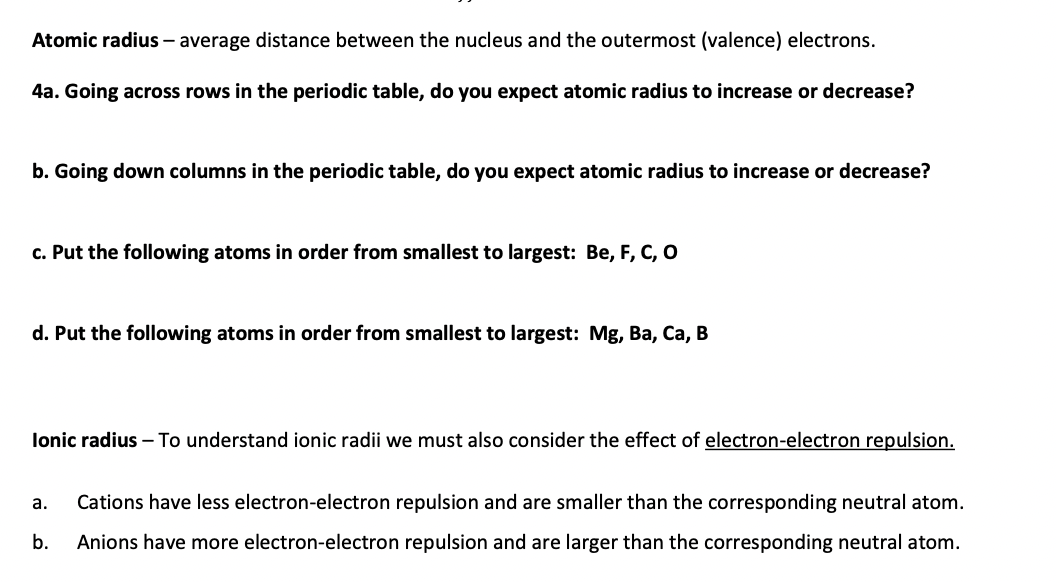4a. Going across rows in the periodic table, do you expect atomic radius to increase or decrease? b. Going down columns in the periodic table, do you expect atomic radius to increase or decrease? c. Put the following atoms in order from smallest to largest: Be, F, C, O d. Put the following atoms in order from smallest to largest: Mg, Ba, Ca, B
4a. Going across rows in the periodic table, do you expect atomic radius to increase or decrease? b. Going down columns in the periodic table, do you expect atomic radius to increase or decrease? c. Put the following atoms in order from smallest to largest: Be, F, C, O d. Put the following atoms in order from smallest to largest: Mg, Ba, Ca, B
Chemistry: An Atoms First Approach
2nd Edition
ISBN:9781305079243
Author:Steven S. Zumdahl, Susan A. Zumdahl
Publisher:Steven S. Zumdahl, Susan A. Zumdahl
Chapter2: Atomic Structure And Periodicity
Section: Chapter Questions
Problem 146AE: An unknown element is a nonmetal and has a valence electron configuration of ns2np4 a. How many...
Related questions
Question

Transcribed Image Text:Atomic radius – average distance between the nucleus and the outermost (valence) electrons.
4a. Going across rows in the periodic table, do you expect atomic radius to increase or decrease?
b. Going down columns in the periodic table, do you expect atomic radius to increase or decrease?
c. Put the following atoms in order from smallest to largest: Be, F, C, O
d. Put the following atoms in order from smallest to largest: Mg, Ba, Ca, B
lonic radius – To understand ionic radii we must also consider the effect of electron-electron repulsion.
а.
Cations have less electron-electron repulsion and are smaller than the corresponding neutral atom.
b.
Anions have more electron-electron repulsion and are larger than the corresponding neutral atom.
Expert Solution
This question has been solved!
Explore an expertly crafted, step-by-step solution for a thorough understanding of key concepts.
Step by step
Solved in 4 steps

Knowledge Booster
Learn more about
Need a deep-dive on the concept behind this application? Look no further. Learn more about this topic, chemistry and related others by exploring similar questions and additional content below.Recommended textbooks for you

Chemistry: An Atoms First Approach
Chemistry
ISBN:
9781305079243
Author:
Steven S. Zumdahl, Susan A. Zumdahl
Publisher:
Cengage Learning

Chemistry: Matter and Change
Chemistry
ISBN:
9780078746376
Author:
Dinah Zike, Laurel Dingrando, Nicholas Hainen, Cheryl Wistrom
Publisher:
Glencoe/McGraw-Hill School Pub Co

General Chemistry - Standalone book (MindTap Cour…
Chemistry
ISBN:
9781305580343
Author:
Steven D. Gammon, Ebbing, Darrell Ebbing, Steven D., Darrell; Gammon, Darrell Ebbing; Steven D. Gammon, Darrell D.; Gammon, Ebbing; Steven D. Gammon; Darrell
Publisher:
Cengage Learning

Chemistry: An Atoms First Approach
Chemistry
ISBN:
9781305079243
Author:
Steven S. Zumdahl, Susan A. Zumdahl
Publisher:
Cengage Learning

Chemistry: Matter and Change
Chemistry
ISBN:
9780078746376
Author:
Dinah Zike, Laurel Dingrando, Nicholas Hainen, Cheryl Wistrom
Publisher:
Glencoe/McGraw-Hill School Pub Co

General Chemistry - Standalone book (MindTap Cour…
Chemistry
ISBN:
9781305580343
Author:
Steven D. Gammon, Ebbing, Darrell Ebbing, Steven D., Darrell; Gammon, Darrell Ebbing; Steven D. Gammon, Darrell D.; Gammon, Ebbing; Steven D. Gammon; Darrell
Publisher:
Cengage Learning


Chemistry
Chemistry
ISBN:
9781305957404
Author:
Steven S. Zumdahl, Susan A. Zumdahl, Donald J. DeCoste
Publisher:
Cengage Learning
